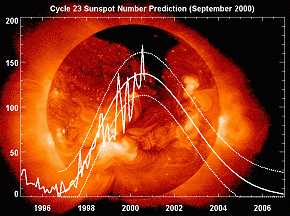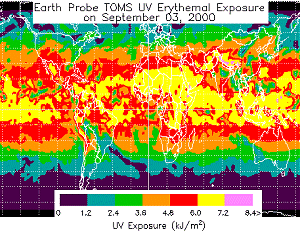|
 Listen to this story (requires RealPlayer) Listen to this story (requires RealPlayer)
 Sept. 5, 2000 -- For many Americans, Labor Day weekend was the last chance to hit the beach during the Summer of 2000. With autumn just around the corner and school starting around the country, droves of sunbathers spent their holiday perfecting a last-minute tan. But was it safe? After all, the Sun is near the peak of its 11-year activity cycle. There are more sunspots, solar flares and UV rays from the Sun than at any time since 1989. Sept. 5, 2000 -- For many Americans, Labor Day weekend was the last chance to hit the beach during the Summer of 2000. With autumn just around the corner and school starting around the country, droves of sunbathers spent their holiday perfecting a last-minute tan. But was it safe? After all, the Sun is near the peak of its 11-year activity cycle. There are more sunspots, solar flares and UV rays from the Sun than at any time since 1989.
"We're in the maximum phase of the solar cycle now," says Dr. David Hathaway, a solar physicist at the NASA Marshall Space Flight Center, "and it will probably persist for another year or more. This one is somewhat smaller than the last two maxima in 1989 and 1979, but it's definitely bigger than average."
Above: The sunspot number is soaring in the year 2000, which marks the peak of another 11-year sunspot cycle. A white curve displaying monthly-averaged International Sunspot Numbers is overlaid on an x-ray image of the Sun. [more information]
Fortunately for beach-goers, elevated levels of solar activity around the peak of the sunspot cycle do not substantially increase the risk of sunburns on Earth. Our planet's atmosphere acts as a shield against the most harmful forms of radiation -- and the shielding actually increases slightly near the peak of the solar cycle. So, if you failed to buy any super-protective Solar Max Sunscreen for your Labor Day on the beach, you can relax. There was nothing to worry about beyond the usual forms of skin cancer and exposure-related maladies.
"There really isn't much going on over the course of a solar cycle that will affect you sitting at the ground...because the atmosphere shields you," says Dr. Richard McPeters, principle investigator for NASA's Total Ozone Mapping Spectrometer (TOMS) at the NASA Goddard Space Flight Center. In space, radiation levels during solar maximum can be much higher than they are at solar minimum, posing hazards to astronauts and orbiting satellites. But, "when you get to the radiation that gets through the atmosphere, the variation [between solar maximum and solar minimum] is very small, less than a percent."
Ultraviolet (UV) radiation comes from the Sun in a range of wavelengths; some are completely blocked by the atmosphere, while others pass through to the Earth's surface.
The light that scientists call UV has wavelengths that range between 400 nanometers (nm) and 100 nm. A nanometer is a billionth of a meter, or one-millionth of a millimeter.
In general, the shorter the radiation's wavelength, the more energy it contains and the more damaging it can be to people, plants and animals. UV radiation with a wavelength of 400 nm -- which is close to visible light -- is not dangerous to people, while 100 nm UV -- which is closer to X-rays (less than 1 nm) -- is very dangerous. Fortunately, atmospheric ozone, oxygen and other gases block out the most dangerous UV photons at wavelengths shorter than 300 nm.

Above: This image, courtesy of Dr. Judith Lean at the US Naval Research Laboratory, shows three extreme ultraviolet (30 nm) pictures of the Sun captured by the ESA/NASA Solar and Heliospheric Observatory at different times during the current solar cycle. In 1996, near solar minimum, the extreme ultraviolet Sun was nearly featureless. Near the peak of the cycle, the Sun is dotted by fiery regions of hot gas trapped in magnetic fields above sunspots and plages. These active regions produce copious numbers of extreme ultra-violet and X-ray photons that are absorbed in outer layers of our atmosphere before they reach Earth's surface.
"The extreme ultraviolet photons that are most intense during the peak of the solar cycle aren't the same as the UV rays that give you sunburns," notes Dr. Judith Lean, a physicist at the US Naval Research Laboratory. "Sunburns come from the UV-A and UV-B bands around 300 nanometers. Extreme ultraviolet photons from the Sun are at least 10 times more energetic than UV-A and UV-B and they vary 100 times more [between solar minimum and solar maximum]. It's a good thing they're all absorbed by nitrogen and oxygen at high altitudes -- otherwise a day at the beach
would be no fun."
SEND THIS STORY TO A FRIEND
Heightened levels of solar ultraviolet radiation can actually strengthen the shielding capacity of Earth's atmosphere by a slight amount.
The increase of UV radiation around 200 nm during Solar Max has the effect of increasing ozone production in the stratosphere. Ozone is formed in the stratosphere when high-energy UV radiation splits oxygen molecules into two oxygen atoms. One of those atoms then recombines with an oxygen molecule to form a three-atom oxygen molecule: ozone.
The exact amount of increase in stratospheric ozone is still debated, but the total increase in the ozone above people's heads is generally agreed to be about 1 or 2 percent during Solar Maximum. This added ozone helps to offset the slight increase in UV radiation at wavelengths that reach the ground.
 "The combined effect of these opposite influences [heightened UV plus heightened shielding] leads to a change in the 'erythemal weighting function' -- a measure of the sunburn-causing power of the UV striking the surface -- of nearly zero during Solar Max," says Dr. Jay Herman, a scientist at the Goddard Space Flight Center who works with NASA's Total Ozone Monitoring Spectrometer (TOMS). Erythema is the scientific word for skin reddening or sunburn. "The combined effect of these opposite influences [heightened UV plus heightened shielding] leads to a change in the 'erythemal weighting function' -- a measure of the sunburn-causing power of the UV striking the surface -- of nearly zero during Solar Max," says Dr. Jay Herman, a scientist at the Goddard Space Flight Center who works with NASA's Total Ozone Monitoring Spectrometer (TOMS). Erythema is the scientific word for skin reddening or sunburn.
Spaceborne TOMS instruments are able to monitor erythemal UV radiation levels on the ground. Every day a new map is published at the TOMS web site. In areas of the globe marked by red, yellow or pink (see above), prolonged exposure to the Sun can be dangerous.
Above: Daily updates of erythemal UV exposure around the world can be found on the TOMS Web site. Colors indicate the intensity of solar ultraviolet radiation reaching plant and animal life after it has been filtered through stratospheric ozone, clouds and aerosols multiplied by its biological damage potential. Red, yellow and pink denote levels that can be especially dangerous with prolonged exposure. [more information]
"From the viewpoint of a beach-goer, the critical thing is the degree of cloudiness," says Herman. "The reason that August is so much more dangerous than April in the northern hemisphere (the two months have approximately the same sun angle) is because August usually has much less cloud cover than April. However, a clear day in either month will have the same effect on health."
"The day of the year is also important because the largest variation of UV irradiance (after clouds) is caused by the slant path of the radiation through the atmosphere. The slant path is at a minimum around the time of the summer solstice," which leads to the largest UV exposure, explained Herman.
Herman says that daily and weekly variations in the ozone layer are much larger than the effect of the solar cycle. "Because of wave activity in the stratosphere and troposphere, there is a considerable variation as a function of longitude (at a fixed latitude). The entire ozone field rotates about the Earth, relative to a fixed point on the ground, in about 2 to 3 weeks. From the viewpoint of an observer on the ground, it appears that the ozone field overhead varies on a daily basis by a few percent at latitudes of 30 degrees and much more at latitudes above 50 degrees," he explained.
 Right: Readers with an internet connection can monitor ozone concentrations for themselves, thanks to near-realtime global maps of ozone column density published at the Earth Probe TOMS web site. In this map, completed on Sept 4, 2000, the Antarctic ozone hole is prominent as a purple region surrounding the south pole. [more
information] Right: Readers with an internet connection can monitor ozone concentrations for themselves, thanks to near-realtime global maps of ozone column density published at the Earth Probe TOMS web site. In this map, completed on Sept 4, 2000, the Antarctic ozone hole is prominent as a purple region surrounding the south pole. [more
information]
The largest changes at middle latitudes are those driven by the Quasi Biennial Oscillation or QBO effect. "This effect is caused by fairly low level winds that first blow eastward and then westward on an approximately 2.3 year cycle," says Herman. "This wind system causes ozone amounts at low and middle latitudes to vary far more than the solar cycle effect." A paper by Herman and collaborators just accepted for publication in the Journal of Geophysical Research describes how QBO oscillations cause multi-year changes in UV irradiance of ±15% at 300 nm and ±5% at 310 nm at the equator and at middle latitudes.
|